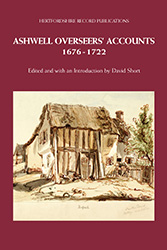
Volume XXXVII, Ashwell overseers’ accounts, 1676-1722, edited by David Short
These overseers’ accounts, covering the period 1676 to 1722, give valuable perspectives on how the poor were treated under the ‘Old Poor Law’, which operated from the end of the sixteenth century until 1834. Parish overseers tried to ensure that relief was restricted to the settled poor of their parish. The ‘Old Poor Law’ had envisaged three major types of relief: putting able-bodied unemployed adults to work and the parish selling the finished goods; paying money, or goods in kind, to relieve adults with physical disabilities, or who were too old and feeble to provide for themselves, or for mothers of infants and very young children who were unable to work because of childcare; putting out pauper children as apprentices. In the Ashwell accounts items listed in the first part of the account are the regular amounts spent each week and it is clear that these are pensions (paid mainly to the elderly). Next come specific items which had been bought or one-off payments of money to individuals; often these recipients are said to be ‘in need’, but sometimes no reason for the payment is obvious. Sums are also paid to various people for services rendered, including nursing the sick, working on the almshouses, assisting with burials people, ‘cleaning Common Brook’, undertaking legal business, fostering children and providing clothes. Other outgoings include travel expenses and paying the clerk, usually the schoolmaster at the Merchant Taylors' School.
Each year in Ashwell two overseers were elected, each being responsible for half a year. This illustrates a key feature of the Old Poor Law: although successive Acts of Parliament laid down general frameworks for policy, much was left to local interpretation and there was a great deal of flexibility in rules and procedures. This edition is a complete transcript of the first surviving volume of their accounts. The original book is generally in good condition but there is some damage and a few illegible entries. The layout and format broadly follows a standard pattern: first, weekly payments are itemised, and then casual payments, details of income, a reconciliation, a statement that the accounts have been approved by the vestry, and the signatures of those who have approved them. Payments were funded by levying a rate, or rates, on householders, although often money had to be laid out before the rate was collected. This implies that overseers had to have sufficient personal finances to lay out certain monies before recouping their expenditure. At the end of their year their accounts had to be approved and any surplus monies handed over to the incoming overseer.
- Edited and with an Introduction by David Short
- xliii + 244 pp
- 6 illustrations, 2 maps, plus illustrated jacket
- ISBN: 978-0-9501741-3-6
Non-Members:
£22
• Members:
£17.50
(+£4 p&p )